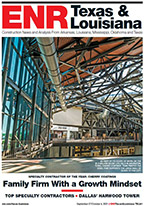The value of new construction starts settled back 4% in October to a seasonally adjusted annual rate of $589.8 billion, according to Dodge Data & Analytics (formerly McGraw Hill Construction). The decline followed the 10% increase reported in September, which was the strongest month for total construction starts so far in 2014.
Both nonresidential building and nonbuilding construction lost momentum in October while residential building posted a moderate gain, given further growth for multifamily housing. During the first 10 months of 2014, total construction starts on an unadjusted basis were $475.8 billion, up 5% from the same period a year ago.
The October statistics lowered the Dodge Index to 125 (2000=100), compared to a revised 129 for September. October’s reading for the Dodge Index was the same as the 125 average for the third quarter and above the 117 average for this year’s January-September period.
“Recent months have shown an up-and-down pattern for construction starts around what is still a rising trend,” said Robert A. Murray, chief economist for Dodge Data & Analytics. “Nonresidential building is making a more substantial contribution this year to the construction expansion, notwithstanding its October decline. Various factors affecting activity for this sector continue to be positive.
“Market fundamentals such as occupancies and rents are strengthening, the investment community is turning increasingly to real estate development and more construction bond measures are getting passed, including several substantial school construction bond measures that achieved passage in Texas during the most recent election,” Murray said.
“This year’s retreat by nonbuilding construction has stayed measured, helped in the near term by the recent $10.8-billion ‘patch’ to the Highway Trust Fund, although the month-to-month performance for nonbuilding construction still reflects the swings shown by the volatile electric utility category. The continued growth for residential building in 2014 is being led by multifamily housing, featuring groundbreaking for numerous multifamily high-rises in major cities, while single family housing remains stalled for now,” he said.
Nonresidential Building
Nonresidential building in October fell 14% to $195.2 billion (annual rate), following its 13% jump in September. The institutional building group, after especially strong activity in September, pulled back 19%. The amusement and recreational category in September had been lifted by the start of such projects as the $948-million Atlanta Falcons stadium in Atlanta and a $717-million casino in the Washington, D.C. area. While October did include the start of the $300-million arena for the Sacramento Kings in Sacramento, Calif., the comparison to the exceptional volume in September produced a 57% decline for the amusement and recreational category.
Educational facilities in October slipped 5%, easing back from earlier gains, although the latest month included groundbreaking for a $201-million University of Texas research center in Austin.
Other educational facilities projects that reached groundbreaking in October included three large high schools, located respectively in Houston ($128 million), San Antonio ($111 million) and Casper, Wyo. ($102 million). October declines were also reported for transportation terminals, down 16%; and public buildings, down 23%. The healthcare facilities category in October rose 11%, with support coming from the start of a $200-million hospital in Buffalo, N.Y., and a $172-million medical center in Austin, Texas. Church construction, while still at a very depressed level, improved 17% in October.
The commercial building group in October held steady with its September pace, reflecting a mixed pattern by project type. Store construction grew 12%, lifted by a $150-million mall expansion in King of Prussia, Pa., while warehouse construction advanced 31%.
Office construction in October slipped 7%, although the latest month did include groundbreaking for several noteworthy project— a $300-million Facebook data center in Altoona, Iowa; a $250-million office tower in San Francisco; and the $132-million office portion of a $195-million office and hotel mixed-use tower in Seattle. Hotel construction in October experienced a similar decline, sliding 8%.
The manufacturing plant category in October dropped 36%, retreating after its 104% surge in September that featured the start of a $1.3-billion methanol plant in Louisiana. Even with its October decline, the manufacturing plant category did include groundbreaking for several massive projects, including a $618-million wing assembly plant for Boeing in Everett, Wash., and a $350-million solar photovoltaic cell manufacturing plant in Buffalo, N.Y.




Post a comment to this article
Report Abusive Comment